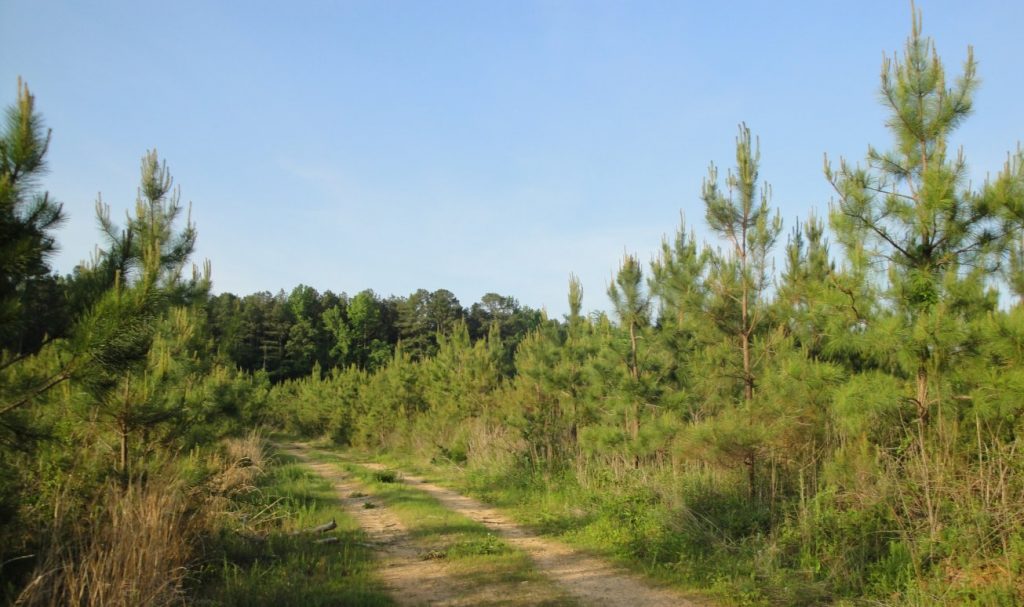
It is obvious that a 100 acre forest ecosystem separated into ten parcels is not the same as one that is fully intact. Even a lightly traveled road cutting through forests may be hard for wildlife to cross. Watch a turtle or a salamander cross a road. Roads divide and can destroy local reptile and amphibian populations as well as change drainage patterns, accelerating runoff and worsening erosion. Small forests also mean practical management and harvest problems. Maybe it is just worth it to deploy a crew or expensive equipment to harvest a few scattered trees. Unfortunately, dividing forests into smaller and smaller units – forest fragmentation – is a continuing problem in Virginia and throughout America. With populations continuing to expand and development continuing to spread out, the situation will only get worse, so we in the forestry community better come up with ways to adapt and maybe even benefit from the trend.
That is why I was interested to hear that Jenifer Gagnon, from Virginia Tech, was developing a program to help real estate agents in Virginia take forestry into account when showing and selling properties to customers who may not have any experience with forestry and who may not ever have even thought about it. The program will give Realtors, land brokers, closing agents and others who deal with rural and large-lot sales continuing education opportunities explaining how important well-managed, healthy forests are to Virginia. It will also include information that helps make a sale, providing sources of cost-share assistance, identifying yard trees, and giving real estate professionals what they need to talk about site quality and productivity Whether they are talking about 100 acres ten, good forest management makes a difference as do the benefits of forest certification programs such as the American Tree Farm System (ATFS) that help connect individual owners to those who can help manage the forests as well as add the value of certification to any timber harvested from the property.
Real estate professionals will also get New Landowner Packets to give their clients (for free). These packets have information about forests in Virginia, describing the services provided by state and federal natural resources agencies and contact information, include information on Tree Farm and the American Forest Foundation, Virginia Forests magazine, and DOF tree ID book. In other words, all they need to get started on good forestry management.
This will not stop forest fragmentation, but it may bring many more landowners into the system of sound and responsible forestry. And when people become aware of the resource and its value, they are better stewards of the land. They may also team up with neighbors to jointly manage, or at least understand the plans of others, which might mitigate the negative effects of fragmentation.
Working with this new type of owner will mean that it is not forestry practiced as usual or as it can be in more isolated rural areas. Forest fragmentation and the likely relatively dense human presence around and within forest parcels will make it more difficult to harvest, spray burn or do many of the things good forestry practices would recommend. On the other hand, having many more landowners involved with and supporting forestry is great. The new forest owners, at least at first, will be on but not of the land, i.e. they will not have the long experience and history with the places they live. But their voices will be increasingly important in protecting and prospering forestry in general. As development creeps farther and farther into the forest, we better hope and work toward the goal that the people, the voters, who come into these new developments understand that trees can be harvested sustainable and that each cutting or thinning does not mean the end of the forest, but rather just another step in its continuing healthy development.
Many people want to live on a working and living landscape; they want to be part of it, not mere separate sojourners. Our modern world makes this harder and harder to do. It is harder to make the connection with the living land if you see trees only as decorations outside your windows. Programs that integrate humans into their surroundings, giving them some feeling of having a stake in the future, are a winning formula all around. Having hundreds of acres under good forestry management is an excellent and tested way to grow timber sustainably while protecting the water, soil and wildlife that lives on the land. We know how to do that. But we will increasingly have to also know how to integrate people into this system. We prefer not to have our forest land fragmented and we should do our best to protect larger tracts whenever we can. But when we can’t, we need to manage the smaller parts right.
All the time I was writing this posting, I kept on thinking of the old Humpty-Dumpty story. You know the one – “Humpty-Dumpty sat on a wall; Humpty Dumpty had a great fall; all the kings horses and all the kings men, couldn’t put Humpty together again.” But I don’t think that is true of forests. Forests are living and adaptive systems. We can adapt too if we just figure out how.
